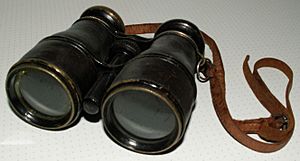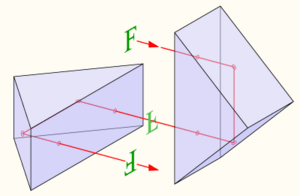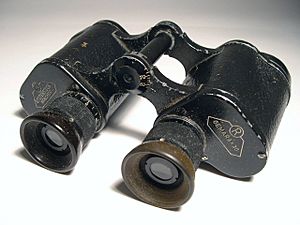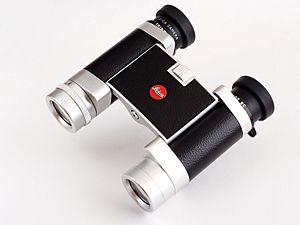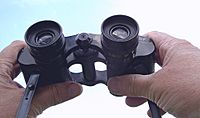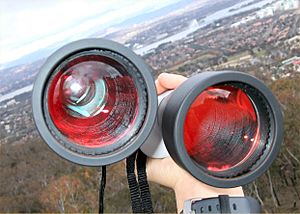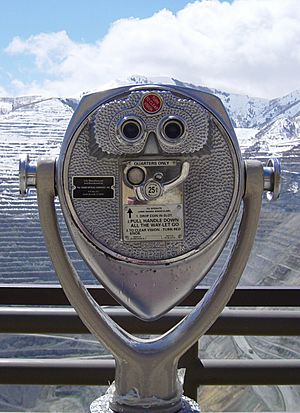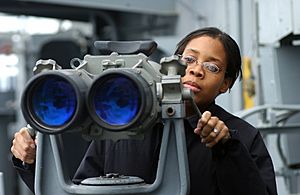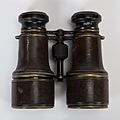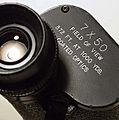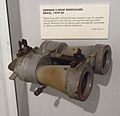Binoculars facts for kids
Binoculars are a kind of tool that lets people see far-away things more clearly, using a technology called optics. They are made of a pair of matched telescopes that are held in front of the user's eyes.
The two telescopes have lenses that focus light and magnify the image, a process called magnification. This way, when someone looks through the binoculars at a far-away object, it looks much closer. They have prisms inside, which bend the light so to shorten the length of the tubes. That is why a binocular is shorter than standard telescopes of similar power.
Binoculars were invented in the 17th century. They allow a telescope user to use both eyes. The Royal Navy used single telescopes, but now all ships have heavy binoculars. Heavy ones can be mounted on swivels to scan the horizon. Binoculars are also standard issue in all armies. Night vision binoculars use photocathode electronics to intensify the image.
Binoculars are also used for theatre (opera glasses), birdwatching and amateur astronomy.
Contents
Features
These features are present in some or all binoculars:
- Focussing is usually by turning knobs.
- Large binoculars have independent focussing for each 'telescope' (each side).
- Eye relief: Eye relief is the distance from the rear eyepiece lens to the exit pupil or eye point. It is the distance the observer must position his or her eye behind the eyepiece in order to see the image. The longer the focal length of the eyepiece, the greater the eye relief. Binoculars may have eye relief ranging from a few millimeters to 2.5 centimeters (1 inch) or more. Eye relief can be particularly important for eyeglass wearers.
- Range finding. Many binoculars have range finding reticle (scale) superimposed on the view. This scale allows the distance to the object to be estimated if the object height is known.
- Image stabilisation. On top-range models, by electronics.
- Optical coatings
- Anti-reflective: not just relections off the front lens, but every lens and prism. Anti-reflective coatings reduce light lost at every optical surface through reflection at each surface. Reducing reflection via anti-reflective coatings also reduces the amount of "lost" light bouncing around inside the binocular which can making the image appear hazy (low contrast).
- Metallic mirror coating for its prisms.
- Warships used very large binocular naval rangefinders (up to 15 metres separation of the two objective lenses, weight 10 tons) for ranging gun targets 25 km away in World War II. Late-20th century technology made this application redundant (radar; laser sights; guided missiles &c).
- Modern military binoculars have filters that block laser weapons used against them. Some are equipped for night vision.
Optical designs
Galilean binoculars
Almost from the invention of the telescope in the 17th century the advantages of mounting two of them side by side for binocular vision seems to have been explored. Most early binoculars used Galilean optics; that is, they used a convex objective and a concave eyepiece lens. The Galilean design has the advantage of presenting an erect image but has a narrow field of view and is not capable of very high magnification. This type of construction is still used in very cheap models and in opera glasses or theater glasses. The Galilean design is also used in low magnification binocular surgical and jewelers' loupes because they can be very short and produce an upright image without extra or unusual erecting optics, reducing expense and overall weight. They also have large exit pupils making centering less critical and the narrow field of view works well in those applications. These are typically mounted on an eyeglass frame or custom-fit onto eyeglasses.
Binoculars with Keplerian optics
An improved image and higher magnification is achieved in binoculars employing Keplerian optics, where the image formed by the objective lens is viewed through a positive eyepiece lens (ocular). Since the Keplerian configuration produces an inverted image, different methods were used to turn the image right way up.
Binoculars with erecting lenses
In aprismatic binoculars with Keplerian optics (which were sometimes called "twin telescopes") each tube has one or two additional lenses (relay lens) between the objective and the ocular. These lenses are used to erect the image. The binoculars with erecting lenses have a serious disadvantage: their length is too long. Such binoculars were popular in the 1800s (for example, G.& S. Merz models), but became obsolete shortly after the Karl Zeiss company introduced improved prism binoculars in the 1890s.
Prism binoculars
Optical prisms added to the design are another way to turn the image right way up, usually in a Porro prism or roof-prisms design.
Porro prism binoculars
Porro prism binoculars are named after Italian optician Ignazio Porro who patented this image erecting system in 1854, which was later refined by makers like the Carl Zeiss company in the 1890s. Binoculars of this type use a Porro prism in a double prism Z-shaped configuration to erect the image. This feature results in binoculars that are wide, with objective lenses that are well separated but offset from the eyepieces. Porro prism designs have the added benefit of folding the optical path so that the physical length of the binoculars is less than the focal length of the objective and wider spacing of the objectives gives a better sensation of depth. Thus, the size of binoculars is reduced.
Roof-prisms binoculars
Binoculars using roof prisms may have appeared as early as the 1870s in a design by Achille Victor Emile Daubresse. Most roof prism binoculars use either the Abbe-Koenig prism (named after Ernst Karl Abbe and Albert Koenig and patented by Carl Zeiss in 1905) or the Schmidt-Pechan prism (invented in 1899) designs to erect the image and fold the optical path. They have objective lenses that are approximately in line with the eyepieces.
Roof-prisms designs create an instrument that is narrower and more compact than Porro prisms. There is also a difference in image brightness. Porro-prism binoculars will inherently produce a brighter image than roof-prism binoculars of the same magnification, objective size, and optical quality, because the roof-prism design employs silvered surfaces that reduce light transmission by 12% to 15%. Roof-prisms designs also require tighter tolerances for alignment of their optical elements (collimation). This adds to their expense since the design requires them to use fixed elements that need to be set at a high degree of collimation at the factory. Porro prisms binoculars occasionally need their prism sets to be re-aligned to bring them into collimation. The fixed alignment in roof-prism designs means the binoculars normally will not need re-collimation.
Optical parameters
Binoculars are usually designed for specific applications. These different designs require certain optical parameters which may be listed on the prism cover plate of the binoculars. Those parameters are:
Magnification
The ratio of the focal length of the eyepiece divided into the focal length of the objective gives the linear magnifying power of binoculars (sometimes expressed as "diameters"). A magnification of factor 7, for example, produces an image 7 times larger than the original seen from that distance. The desirable amount of magnification depends upon the intended application, and in most binoculars is a permanent, non-adjustable feature of the device (zoom binoculars are the exception). Hand-held binoculars typically have magnifications ranging from 7x to 10x so they will be less susceptible to the effects of shaking hands. A larger magnification leads to a smaller field of view and may require a tripod for image stability. Some specialized binoculars for astronomy or military use have magnifications ranging from 15x to 25x.
Objective diameter
The diameter of the objective lens determines how much light can be gathered to form an image. This number directly affects performance. When magnification and quality are equal, the larger the second binocular number the brighter the image as well as the sharper the image. An 8×40, then, will produce a brighter and sharper image than an 8×25, even though both enlarge the image an identical eight times. The larger front lenses in the 8×40 also produce wider beams of light (exit pupil) that leave the eyepieces. This makes it more comfortable to view with an 8×40 than an 8×25. It is usually expressed in millimeters. It is customary to categorize binoculars by the magnification × the objective diameter; e.g. 7×50. Smaller binoculars may have a diameter of as low as 22 mm; 35 mm and 50 mm is a common diameter for field binoculars; astronomical binoculars have diameters ranging from 70 mm to 150 mm.
Field of view
The field of view of a pair of binoculars is determined by its optical design. It is usually notated in a linear value, such as how many feet (meters) in width will be seen at 1,000 yards (or 1,000 m), or in an angular value of how many degrees can be viewed.
Exit pupil
Binoculars concentrate the light gathered by the objective into a beam, the exit pupil, whose diameter is the objective diameter divided by the magnifying power. For maximum effective light-gathering and brightest image, the exit pupil should equal the diameter of the fully dilated iris of the human eye — about 7 mm, reducing with age. If the cone of light streaming out of the binoculars is larger than the pupil it is going into, any light larger than the pupil is wasted and does not provide information to the eye. In daytime use the human pupil is typically dilated about 3 mm, which is about the exit pupil of a 7×21 binocular. Much larger 7×50 binoculars will produce a cone of light bigger than the pupil it is entering, and this light will, in the day, be wasted. It is therefore seemingly pointless to carry around a larger instrument. However, a larger exit pupil makes it easier to put the eye where it can receive the light: anywhere in the large exit pupil cone of light will do. This ease of placement helps avoid vignetting, which is a darkened or obscured view that occurs when the light path is partially blocked, and it means that the image can be quickly found which is important when looking at birds or game animals that move rapidly, or for a seaman on the deck of a pitching boat or ship. Narrow exit pupil binoculars may also be fatiguing because the instrument must be held exactly in place in front of the eyes to provide a useful image. Finally, many people use their binoculars at dusk, in overcast conditions, and at night, when their pupils are larger. Thus the daytime exit pupil is not a universally desirable standard. For comfort, ease of use, and flexibility in applications, larger binoculars with larger exit pupils are satisfying choices even if their capability is not fully used by day.
Eye relief
Eye relief is the distance from the rear eyepiece lens to the exit pupil or eye point. It is the distance the observer must position his or her eye behind the eyepiece in order to see an unvignetted image. The longer the focal length of the eyepiece, the greater the eye relief. Binoculars may have eye relief ranging from a few millimeters to 2.5 centimeters or more. Eye relief can be particularly important for eyeglass wearers. The eye of an eyeglass wearer is typically further from the eye piece which necessitates a longer eye relief in order to still see the entire field of view. Binoculars with short eye relief can also be hard to use in instances where it is difficult to hold them steady.
Close focus distance
Close focus distance is the closest point that the binocular can focus on. This distance varies from about 0.5 m to 30 m, depending upon the design of the binoculars.
Eyepieces
Binocular eyepieces usually consist of three or more lens elements in two or more groups. The lens furthest from the viewer's eye is called the field lens and that closest to the eye the eye lens. The most common configuration is that invented in 1849 by Carl Kellner. In this arrangement, the eye lens is a plano-concave/ double convex achromatic doublet (the flat part of the former facing the eye) and the field lens is a double-convex singlet. A reversed Kellner eyepiece was developed in 1975 and in it the field lens is a double concave/ double convex achromatic doublet and the eye lens is a double convex singlet. The reverse Kellner provides 50% more eye relief and works better with small focal ratios as well as having a slightly wider field.
Wide field binoculars typically utilize some kind of Erfle configuration, patented in 1921. These have five or six elements in three groups. The groups may be two achromatic doublets with a double convex singlet between them or may all be achromatic doublets. These eyepieces tend not to perform as well as Kellner eyepieces at high power because they suffer from astigmatism and ghost images. However they have large eye lenses, excellent eye relief, and are comfortable to use at lower powers.
Mechanical design
Focus and adjustment
Binoculars have a focusing arrangement which changes the distance between ocular and objective lenses. Normally there are two different arrangements used to provide focus, "independent focus" and "central focusing":
- Independent focus is an arrangement where the two telescopes are focused independently by adjusting each eyepiece. Binoculars designed for heavy field use, such as military applications, traditionally have used independent focusing.
- Central focusing is an arrangement which involves rotation of a central focusing wheel to adjust both tubes together. In addition, one of the two eyepieces can be further adjusted to compensate for differences between the viewer's eyes (usually by rotating the eyepiece in its mount). Because the focal change effected by the adjustable eyepiece can be measured in the customary unit of refractive power, the diopter, the adjustable eyepiece itself is often called a diopter. Once this adjustment has been made for a given viewer, the binoculars can be refocused on an object at a different distance by using the focusing wheel to adjust both tubes together without eyepiece readjustment.
There are "focus-free" or "fixed-focus" binoculars that have no focusing mechanism other than the eyepiece adjustments that are meant to be set for the user's eyes and left fixed. These are considered to be compromise designs, suited for convenience, but not well suited for work that falls outside their designed range.
Binoculars can be generally used without eyeglasses by myopic (near-sighted) or hyperopic (far-sighted) users simply by adjusting the focus a little further. Most manufacturers leave a little extra available focal-range beyond the infinity-stop/setting to account for this when focusing for infinity. People with severe astigmatism, however, may still need to use their glasses while using binoculars.
Some binoculars have adjustable magnification, zoom binoculars, intended to give the user the flexibility of having a single pair of binoculars with a wide range of magnifications, usually by moving a "zoom" lever. This is accomplished by a complex series of adjusting lenses similar to a zoom camera lens. These designs are noted to be a compromise and even a gimmick since they add bulk, complexity and fragility to the binocular. The complex optical path also leads to a narrow field of view and a large drop in brightness at high zoom. Models also have to match the magnification for both eyes throughout the zoom range and hold collimation to avoid eye strain and fatigue.
Most modern binoculars are also adjustable via a hinged construction that enables the distance between the two telescope halves to be adjusted to accommodate viewers with different eye separation or "interpupillary distance". Most are optimized for the interpupillary distance (typically 56 mm) for adults.
Image stability
Some binoculars use image-stabilization technology to reduce shake at higher magnifications. This is done by having a gyroscope move part of the instrument, or by powered mechanisms driven by gyroscopic or inertial detectors, or via a mount designed to oppose and damp the effect of shaking movements. Stabilization may be enabled or disabled by the user as required. These techniques allow binoculars up to 20× to be hand-held, and much improve the image stability of lower-power instruments. There are some disadvantages: the image may not be quite as good as the best unstabilized binoculars when tripod-mounted, stabilized binoculars also tend to be more expensive and heavier than similarly specified non-stabilised binoculars.
Alignment
The two telescopes in binoculars are aligned in parallel (collimated), to produce a single circular, apparently three-dimensional, image. Misalignment will cause the binoculars to produce a double image. Even slight misalignment will cause vague discomfort and visual fatigue as the brain tries to combine the skewed images.
Alignment is performed by small movements to the prisms, by adjusting an internal support cell or by turning external set screws, or by adjusting the position of the objective via eccentric rings built into the objective cell. Alignment is usually done by a professional, although the externally mounted adjustment features can be accessed by the end user.
Optical coatings
Because a typical binocular has 6 to 10 optical elements with special characteristics and up to 16 air-to-glass surfaces, binocular manufacturers use different types of optical coatings for technical reasons and to improve the image they produce.
Anti-reflective coatings
Anti-reflective coatings reduce light lost at every optical surface through reflection at each surface. Reducing reflection via anti-reflective coatings also reduces the amount of "lost" light present inside the binocular which can make the image appear hazy (low contrast). A pair of binoculars with good optical coatings may yield a brighter image than uncoated binoculars with a larger objective lens, on account of superior light transmission through the assembly. A classic lens-coating material is magnesium fluoride, which reduces reflected light from 5% to 1%. Modern lens coatings consist of complex multi-layers and reflect only 0.25% or less to yield an image with maximum brightness and natural colors.
Phase correction coatings
In binoculars with roof prisms the light path is split into two paths that reflect on either side of the roof prism ridge. One half of the light reflects from roof surface 1 to roof surface 2. The other half of the light reflects from roof surface 2 to roof surface 1. This causes the light to become partially polarized (due to a phenomenon called Brewster's angle). During subsequent reflections the direction of this polarization vector is changed but it is changed differently for each path in a manner similar to a Foucault pendulum. When the light following the two paths is recombined the polarization vectors of each path do not coincide. The angle between the two polarization vectors is called the phase shift, or the geometric phase, or the Berry phase. This interference between the two paths with different geometric phase results in a varying intensity distribution in the image reducing apparent contrast and resolution compared to a porro prism erecting system. These unwanted interference effects can be suppressed by vapor depositing a special dielectric coating known as a phase-correction coating or P-coating on the roof surfaces of the roof prism. This coating corrects for the difference in geometric phase between the two paths so both have effectively the same phase shift and no interference degrades the image.
Binoculars using either a Schmidt–Pechan roof prism or an Abbe–Koenig roof prism benefit from phase coatings. Porro prism binoculars do not split beams and therefore they do not require any phase coatings.
Metallic mirror coatings
In binoculars with Schmidt–Pechan roof prisms, mirror coatings are added to some surfaces of the roof prism because the light is incident at one of the prism's glass-air boundaries at an angle less than the critical angle so total internal reflection does not occur. Without a mirror coating most of that light would be lost. Schmidt–Pechan roof prism aluminum mirror coating (reflectivity of 87% to 93%) or silver mirror coating (reflectivity of 95% to 98%) is used.
In older designs silver mirror coatings were used but these coatings oxidized and lost reflectivity over time in unsealed binoculars. Aluminum mirror coatings were used in later unsealed designs because they did not tarnish even though they have a lower reflectivity than silver. Modern designs use either aluminum or silver. Silver is used in modern high-quality designs which are sealed and filled with a nitrogen or argon inert atmosphere so that the silver mirror coating does not tarnish.
Porro prism binoculars and roof prism binoculars using the Abbe–Koenig roof prism typically do not use mirror coatings because these prisms reflect with 100% reflectivity using total internal reflection in the prism.
Dielectric mirror coatings
Dielectric coatings are used in Schmidt–Pechan roof prisms to cause the prism surfaces to act as a dielectric mirror. The non-metallic dielectric reflective coating is formed from several multilayers of alternating high and low refractive index materials deposited on the roof prism's reflective surfaces. Each single multilayer reflects a narrow band of light frequencies so several multilayers, each tuned to a different color, are required to reflect white light. This multi-multilayer coating increases reflectivity from the prism surfaces by acting as a distributed Bragg reflector. A well-designed dielectric coating can provide a reflectivity of more than 99% across the visible light spectrum. This reflectivity is much improved compared to either an aluminium mirror coating (87% to 93%) or silver mirror coating (95% to 98%).
Porro prism binoculars and roof prism binoculars using the Abbe–Koenig roof prism do not use dielectric coatings because these prisms reflect with very high reflectivity using total internal reflection in the prism rather than requiring a mirror coating.
Terms used to describe coatings
For all binoculars
The presence of any coatings is typically denoted on binoculars by the following terms:
- coated optics: one or more surfaces are anti-reflective coated with a single-layer coating.
- fully coated: all air-to-glass surfaces are anti-reflective coated with a single-layer coating. Plastic lenses, however, if used, may not be coated.
- multi-coated: one or more surfaces have anti-reflective multi-layer coatings.
- fully multi-coated: all air-to-glass surfaces are anti-reflective multi-layer coated.
For binoculars with roof prisms only (not needed for Porro prisms)
- phase-coated or P-coating: the roof prism has a phase-correcting coating
- aluminium-coated: the roof prism mirrors are coated with an aluminium coating (the default if a mirror coating isn't mentioned).
- silver-coated: the roof prism mirrors are coated with a silver coating
- dielectric-coated: the roof prism mirrors are coated with a dielectric coating
Applications
General use
Hand-held binoculars range from small 3 × 10 Galilean opera glasses, used in theaters, to glasses with 7 to 12 diameters magnification and 30 to 50 mm objectives for typical outdoor use.
Many tourist attractions have installed pedestal-mounted, coin-operated binoculars to allow visitors to obtain a closer view of the attraction.
Land Surveys and Geographic Data Collection
Although technology has surpassed using binoculars for data collection, historically these were advanced tools used by geographers and other geoscientists. Field glasses still today can provide visual aid when surveying large areas.
Bird watching
Birdwatching is a very popular hobby among nature and animal lovers and a binocular is their most basic tool. Typically binoculars with a magnification of 7x to 10x are used.
Hunting
Hunters commonly use binoculars in the field as a way to see game animals that are too far away to spot with the naked eye. Hunters most commonly use 8x binoculars with light transmission and large enough objectives to gather light in low light conditions.
Range finding
Many binoculars have a range finding reticle (scale) superimposed upon the view. This scale allows the distance to the object to be estimated if the object's height is known (or estimable). The common mariner 7×50 binoculars have these scales with the angle between marks equal to 5 mil. One mil is equivalent to the angle between the top and bottom of an object one meter in height at a distance of 1000 meters.
Therefore, to estimate the distance to an object that is a known height the formula is:
where:
 is the Distance to the object in meters.
is the Distance to the object in meters. is the known Object Height.
is the known Object Height. is the angular height of the object in number of Mil.
is the angular height of the object in number of Mil.
With the typical 5 mil scale (each mark is 5 mil), a lighthouse that is 3 marks high that is known to be 120 meters tall is 8000 meters distance.
Military

Binoculars have a long history of military use. Galilean designs were widely used up to the end of the 19th century when they gave way to porro prism types. Binoculars constructed for general military use tend to be more rugged than their civilian counterparts. They generally avoid fragile center focus arrangements in favor of independent focus, which also makes for easier, more effective weatherproofing. Prism sets in military binoculars may have redundant aluminized coatings on their prism sets to guarantee they don't lose their reflective qualities if they get wet.
One variant form was called "trench binoculars", a combination of binoculars and periscope, often used for artillery spotting purposes. It projected only a few inches above the parapet, thus keeping the viewer's head safely in the trench.
Military binoculars of the Cold War era were sometimes fitted with passive sensors that detected active IR emissions, while modern ones usually are fitted with filters blocking laser beams used as weapons. Further, binoculars designed for military usage may include a stadiametric reticle in one ocular in order to facilitate range estimation.
There are binoculars designed specifically for civilian and military use at sea. Hand held models will be 5× to 7× but with very large prism sets combined with eyepieces designed to give generous eye relief. This optical combination prevents the image vignetting or going dark when the binoculars are pitching and vibrating relative to the viewer's eye. Large, high-magnification models with large objectives are also used in fixed mountings.
Very large binocular naval rangefinders (up to 15 meters separation of the two objective lenses, weight 10 tons, for ranging World War II naval gun targets 25 km away) have been used, although late-20th century technology made this application mostly redundant.
Astronomical
Binoculars are widely used by amateur astronomers; their wide field of view makes them useful for comet and supernova seeking (giant binoculars) and general observation (portable binoculars). Binoculars specifically geared towards astronomical viewing will have larger aperture objectives (in the 70 mm or 80 mm range) because the diameter of the objective lens increases the total amount of light captured, and therefore determines the faintest star that can be observed. Binoculars designed specifically for astronomical viewing (often 80 mm and larger) are sometimes designed without prisms in order to allow maximum light transmission. Such binoculars also usually have changeable eyepieces to vary magnification. Binoculars with high magnification and heavy weight usually require some sort of mount to stabilize the image. A magnification of 10x is generally considered the practical limit for observation with handheld binoculars. Binoculars more powerful than 15×70 require support of some type. Much larger binoculars have been made by amateur telescope makers, essentially using two refracting or reflecting astronomical telescopes.
Of particular relevance for low-light and astronomical viewing is the ratio between magnifying power and objective lens diameter. A lower magnification facilitates a larger field of view which is useful in viewing the Milky Way and large nebulous objects (referred to as deep sky objects) such as the nebulae and galaxies. The large (typical 7 mm using 7x50) exit pupil [objective (mm)/power] of these devices results in a small portion of the gathered light not being usable by individuals whose pupils do not sufficiently dilate. For example, the pupils of those over 50 rarely dilate over 5 mm wide. The large exit pupil also collects more light from the background sky, effectively decreasing contrast, making the detection of faint objects more difficult except perhaps in remote locations with negligible light pollution. Many astronomical objects of 8 magnitude or brighter, such as the star clusters, nebulae and galaxies listed in the Messier Catalog, are readily viewed in hand-held binoculars in the 35 to 40 mm range, as are found in many households for birding, hunting, and viewing sports events. For observing smaller star clusters, nebulae, and galaxies binocular magnification is an important factor for visibility because these objects appear tiny at typical binocular magnifications.

Some open clusters, such as the bright double cluster (NGC 869 and NGC 884) in the constellation Perseus, and globular clusters, such as M13 in Hercules, are easy to spot. Among nebulae, M17 in Sagittarius and the North American nebula (NGC 7000) in Cygnus are also readily viewed. Binoculars can show a few of the wider-split binary stars such as Albireo in the constellation Cygnus.
A number of solar system objects that are mostly to completely invisible to the human eye are reasonably detectable with medium-size binoculars, including larger craters on the Moon; the dim outer planets Uranus and Neptune; the inner "minor planets" Ceres, Vesta and Pallas; Saturn's largest moon Titan; and the Galilean moons of Jupiter. Although visible unaided in pollution-free skies, Uranus and Vesta require binoculars for easy detection. 10×50 binoculars are limited to an apparent magnitude of +9.5 to +11 depending on sky conditions and observer experience. Asteroids like Interamnia, Davida, Europa and, unless under exceptional conditions Hygiea, are too faint to be seen with commonly sold binoculars. Likewise too faint to be seen with most binoculars are the planetary moons except the Galileans and Titan, and the dwarf planets Pluto and Eris. Other difficult binocular targets include the phases of Venus and the rings of Saturn. Only binoculars with very high magnification, 20x or higher, are capable of discerning Saturn's rings to a recognizable extent. High-power binoculars can sometimes show one or two cloud belts on the disk of Jupiter if optics and observing conditions are sufficiently good.
Images for kids
-
Parameters listed on the prism cover plate describing 7 power magnification binoculars with a 50 mm objective diameter and a 372 foot (113 m) field of view at 1,000 yards (914 m)
-
German U.D.F. 7×50 blc U-boat binoculars (1939–1945)
-
7×50 marine binoculars with dampened compass
See also
 In Spanish: Prismáticos para niños
In Spanish: Prismáticos para niños




